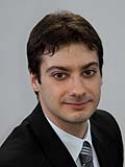
Biography:
Salvatore Sessa received his M.Sc. degrees and Ph.D. in Electronic and Control Engineering from the University of Catania, Catania, Italy in 2004 and 2008 respectively. His PhD was fund by STMictroelectronics, and the thesis title was "Mobile Robots in indoor environments: Localization, Navigation and Enhanced Teleguide".
He received in 2009 a scholarship awarded by Japan Society for the Promotion of Science "JSPS Postdoctoral Fellowship for Foreign Researchers" to conduct research in Japan for a period of 2 years. He was Visiting Researcher at Takanishi Lab in Waseda University from 2009 to 2010. In this period, his research was focused on inertial sensors for human motion analysis.
He received royalty for the rights of commercialization of the 9-axis wireless motion sensor e-nuvo IMU-Z, which is based on the design of the WB-3 (Waseda Bioinstrumentation system No.3)
He received the best scientific paper award at the IEEE/ASME International Conference on Advanced Intelligent Mechatronics (AIM2009), he was finalist for the best scientific paper award at the International Symposium on Robotic and Intelligent System (IRIS 2010), and the International Conference on Robotics and Biomimetics (ROBIO 2010).
He is currently Assistant Professor at the Graduate School of Advanced Science and Engineering at Waseda University, Tokyo, Japan. He is also Adjunct Professor at the Department of Mechatronics and Robotics Engineering at E-Just, Alexandria, Egypt.
His major research interests are in the fields of optimized firmware libraries for embedded systems; human motion tracking systems using inertial sensors; innovative methods on navigation, localization and mapping of mobile robots; sensor fusion of inertial navigation systems, laser scanner and environmental cameras; mobile robot teleoperation using 3D facilities.
Dr. Sessa is Reviewer for many International Robotics Journals and Conferences, such as: Journal of Intelligent and Robotic Systems, ICRA, IROS, ICORR. Since 2009, he is member of the Institute of Electrical and Electronics Engineers (IEEE).
Abstract:
In recent years, there has been an increasing interest in the evaluation of the performance of surgeons and doctors both during training and during clinical activities, to improve the quality and the performance of surgical operation and clinical treatment, such as laparoscopy, endoscopy, neurosurgery, jaw motion tracking, and so on.
Current evaluations systems, however, are still quite limited in the range of possible application scenarios and in their flexibility.Objective of this lecture is to present the development of a set of extremely small, portable, and easy to use motion capture systems, and the relative evaluation methodologies, which can be applied in all the situations where conventional motion capture systems are not practical nor effective (for size, cost, weight, and performances).
The prototypes of the Ultra-miniaturized Inertial Measurement Units "Waseda Bioinstrumentation version 3" and "Waseda Bioinstrumentation version 4" will be presented in detail, together with some of their applications for human analysis, in particular for the quantitative performance assessment.